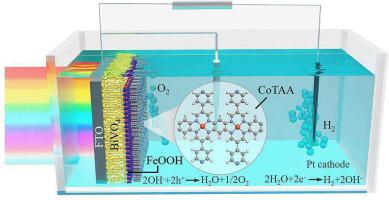当前位置:
X-MOL 学术
›
Chem. Eng. J.
›
论文详情
Our official English website, www.x-mol.net, welcomes your
feedback! (Note: you will need to create a separate account there.)
Regulating the binding strength of oxygen intermediates with a conductive π–d conjugated metal-organic polymer CoTAA on BiVO4 photoanode for efficient photoelectrochemical water oxidation
Chemical Engineering Journal ( IF 13.3 ) Pub Date : 2024-02-05 , DOI: 10.1016/j.cej.2024.149400
Liang Zhu , Zhifu Liang , Shouguo Zhu , Yingpeng Cheng , Zhongfei Li , Haiwei Du , Chuhong Zhu , Daochuan Jiang , Yupeng Yuan
Chemical Engineering Journal ( IF 13.3 ) Pub Date : 2024-02-05 , DOI: 10.1016/j.cej.2024.149400
Liang Zhu , Zhifu Liang , Shouguo Zhu , Yingpeng Cheng , Zhongfei Li , Haiwei Du , Chuhong Zhu , Daochuan Jiang , Yupeng Yuan

|
The slow charge transfer and sluggish water oxidation reaction kinetics represent the main obstacles in the advancement of efficient BiVO4 photoanodes for photoelectrochemical (PEC) water splitting. Herein, a conductive π-d conjugated metal–organic polymer composed of 1,4,8,11-tetraaza[14]annulene (TAA) and atomically dispersed Co sites (CoTAA) was developed as an efficient oxygen evolution catalyst (OEC) to overcome these limitations. In CoTAA, the highly delocalized π-d conjugation results in superior electrical conductivity, leading to improved charge transfer. Additionally, X-ray absorption fine structure (XAFS) spectra and theoretical simulations reveal that the atomically dispersed Co sites within CoTAA, configured as Co-N4 , modulates the binding strength of water oxidation intermediates (*OH, *O, and *OOH), thereby decreasing the energy barrier and facilitating the water oxidation reaction kinetics. Consequently, when combining with ultrathin FeOOH withdrawing the holes, the optimized CoTAA/FeOOH/BiVO4 photoanode achieves a high photocurrent density of 4.97 mA cm−2 at 1.23 VRHE under one sun irradiation (100 mW cm−2 ). This photocurrent represents a 2.59-fold enhancement when compared to that of pure BiVO4 . These findings demonstrate the tremendous potential of π-d conjugated metal–organic polymers as active OECs in enhancing the PEC performance of water splitting.
中文翻译:

利用 BiVO4 光阳极上的导电 π-d 共轭金属有机聚合物 CoTAA 调节氧中间体的结合强度,实现高效光电化学水氧化
缓慢的电荷转移和缓慢的水氧化反应动力学是发展用于光电化学(PEC)水分解的高效 BiVO4 光阳极的主要障碍。在此,开发了一种由1,4,8,11-四氮杂[14]轮烯(TAA)和原子分散的Co位点(CoTAA)组成的导电π-d共轭金属有机聚合物作为有效的析氧催化剂(OEC)克服这些限制。在 CoTAA 中,高度离域的 π-d 共轭导致优异的导电性,从而改善电荷转移。此外,X 射线吸收精细结构 (XAFS) 光谱和理论模拟表明,CoTAA 中原子分散的 Co 位点(配置为 Co-N4)可调节水氧化中间体(*OH、*O 和 *OOH)的结合强度,从而降低能垒并促进水氧化反应动力学。因此,当与收回空穴的超薄 FeOOH 结合时,优化的 CoTAA/FeOOH/BiVO4 光阳极在一次太阳照射(100 mW cm−2)下在 1.23 VRHE 下实现了 4.97 mA cm−2 的高光电流密度。与纯 BiVO4 相比,该光电流增强了 2.59 倍。这些发现证明了 π-d 共轭金属有机聚合物作为活性 OEC 在增强水分解的 PEC 性能方面具有巨大潜力。
更新日期:2024-02-05
中文翻译:

利用 BiVO4 光阳极上的导电 π-d 共轭金属有机聚合物 CoTAA 调节氧中间体的结合强度,实现高效光电化学水氧化
缓慢的电荷转移和缓慢的水氧化反应动力学是发展用于光电化学(PEC)水分解的高效 BiVO4 光阳极的主要障碍。在此,开发了一种由1,4,8,11-四氮杂[14]轮烯(TAA)和原子分散的Co位点(CoTAA)组成的导电π-d共轭金属有机聚合物作为有效的析氧催化剂(OEC)克服这些限制。在 CoTAA 中,高度离域的 π-d 共轭导致优异的导电性,从而改善电荷转移。此外,X 射线吸收精细结构 (XAFS) 光谱和理论模拟表明,CoTAA 中原子分散的 Co 位点(配置为 Co-N4)可调节水氧化中间体(*OH、*O 和 *OOH)的结合强度,从而降低能垒并促进水氧化反应动力学。因此,当与收回空穴的超薄 FeOOH 结合时,优化的 CoTAA/FeOOH/BiVO4 光阳极在一次太阳照射(100 mW cm−2)下在 1.23 VRHE 下实现了 4.97 mA cm−2 的高光电流密度。与纯 BiVO4 相比,该光电流增强了 2.59 倍。这些发现证明了 π-d 共轭金属有机聚合物作为活性 OEC 在增强水分解的 PEC 性能方面具有巨大潜力。

































 京公网安备 11010802027423号
京公网安备 11010802027423号